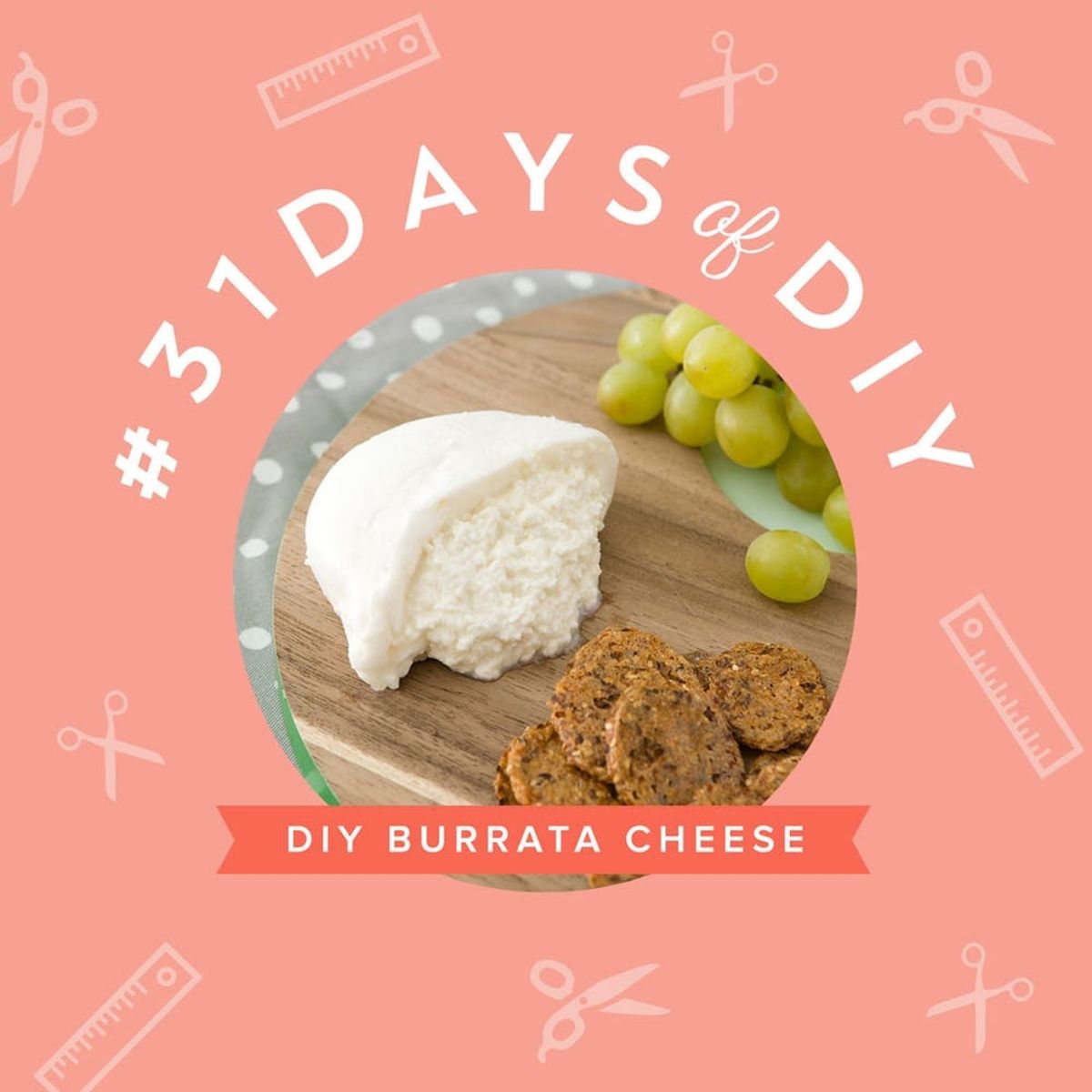Creamy burrata made from scratch? Yes please.
How to Make Your Own Burrata from Scratch

For today’s installment of #31DaysofDIY, we’re making cheese. And not just any cheese — fancy, shmancy and surprisingly doable burrata! We made this delicious recipe in only an hour using Urban Cheesecraft’s Burrata + Mascarpone Kit. If making your own cheese seems daunting, we totally understand. But don’t worry! With the help of Urban Cheesecraft’s kit and instructions, we’re now officially cheese-making pros and we’re happy to share the knowledge. Read on for the recipe!
No idea what #31DaysofDIY is? It’s a brand new tradition here at Brit + Co that’s all about kicking off 2015 right. We’ve challenged ourselves to make or learn something new every single day for the month of January, and we’re inviting all of you along for the ride. From DIY basics like Sewing 101 to learning to design and laser cut our own stencils, we hope this month of making inspires you to make all year long.
Ingredients
– 1 gallon whole cow’s milk (not ultra-pasteurized)
– 3/4 cup heavy cream
– 1 1/2 tsp citric acid
– 1/4 rennet tablet
– 3/4 cup cool, chlorine-free water
– 2 tsp cheese salt
Tools + Materials
– measuring cups
– measuring spoons
– large pot
– mixing bowls
– thermometer
– large slotted spoon
– knife
– mixing spoon
– rubber gloves
Instructions
1. Dissolve 1/4 rennet tablet into 1/4 cup of cool, chlorine-free water. Stir and set aside.
2. Stir 1 1/2 teaspoons citric acid into 1/2 cup of cool water until dissolved.
3. Pour the gallon of milk and 1/2 cup of heavy cream into the pot, then add the citric acid solution. Stir thoroughly.
4. Heat on medium-low heat to 90 degrees F.
5. When it reaches 90 degrees F, thoroughly stir in your rennet solution with 15-20 quick strokes.
6. Heat the milk to 110 degrees F, looking for signs of coagulation.
7. Lower the heat as low as it will go, then cut the curd into 1 1/2 inch cubes with your knife. Gently stir for two to three more minutes.
8. Prepare the burrata filling: Scoop 1/2 cup of curd into a small bowl and gently squeeze out excess whey, adding the whey back to the pot. Add 1/4 teaspoon cheese salt to the dry curd. You can also add the remaining 1/4 cup heavy cream if you’d like your filling to be extra creamy.
9. Create a whey bath for the rest of your curd: Transfer the curds into a large heat-resistant bowl, then add one cup of the cool, chlorine-free water. Then ladle two cups of hot whey (make sure the whey is 190 degrees F). Let the curds sit in this bath for two minutes.
10. Add three more cups of the hot whey onto the curds, and let sit for two more minutes. The cheese should start to feel more solid. Fold it over itself twice.
11. Add three more cups of hot whey to the curd, then let sit for three minutes. Gently fold and press the curd until it starts to hold together.
12. Sprinkle the mass of curd with cheese salt while holding it above the whey bath, then mix in the salt in about five stretches. Shape it into a ball, then into a disk.
13. Transfer the flattened circle of curd to a plate and add your creamy filling to the center. Wrap the edges around the creamy curd, ensuring your filling stays enclosed within it. Pinch the ends to create a seal. Then EAT!
Let’s get started, shall we?
First off, dissolve 1/4 rennet tablet in 1/4 cup cool, chlorine-free water. We used distilled water for this. Wrap the remains of your rennet tablet and store it in your freezer — it’s good for up to two years. In a separate bowl, stir 1 1/2 teaspoons citric acid into 1/2 cup cool, chlorine free water until dissolved.
Pour the gallon of milk and 1/2 cup of heavy cream into a pot. (Note that you should still have 1/4 cup heavy cream set aside for a later step.) Now add the citric acid solution and stir thoroughly. Heat on low to medium heat to 90 degrees F. Stir occasionally to prevent the milk from sticking to the sides of your pot.
Alright, it’s time to focus: When your milk reaches 90 degrees F, thoroughly stir in the rennet solution with 15 to 20 quick strokes. The goal is to evenly distribute the rennet throughout the entire pot without feeling the milk thicken. Continue to heat the milk to 110 degrees F. The milk should be coagulating now. (Yay, science!) Look for clumps of white curd floating in yellow-ish whey, or a solid mass of yogurt-like curd.
Pro Tip: Not seeing any curd? Is your whey still milky white, not yellow? If so, heat your milk for one more minute (don’t go over 110 degrees F). Don’t stir the milk while heating. If your milk still doesn’t coagulate, take the pot off the heat, cover, and let rest for one hour.
Once your coagulated milk reaches 110 degrees F, turn the heat to the lowest possible temperature on your stove. Gently cut the curd into 1 1/2 inch cubes with your knife, like pictured above. Make sure you cut through the full layer. Then lightly stir the pieces in the hot whey for two to three minutes. This VIP step toughens the curd!
When all of the curds have lost their sharp edges, are mostly evenly sized and have the texture of scrambled eggs, turn off the heat.
It’s time to make the filling (which is the best part of burrata, duh). Don your rubber gloves and transfer 1/2 cup curd to a bowl with a slotted spoon, gently squeezing out excess whey with your hands. Add this whey back to the pot. Now add 1/4 teaspoon cheese salt. You can also add your extra 1/4 cup heavy cream, if you want a creamier filling.
Let’s get back to the rest of the curds: These babies are getting a bath. A whey bath, to be specific.* Using your slotted spoon, scoop the rest of the curds out of your pot and into a large bowl. Make sure they’re distributed evenly in the bowl. Heat up the pot of whey to 190 degrees F. Once your whey is at the right temperature, add one cup of cool, chlorine-free water to your bowl of curds. Then add two cups of hot whey into the same bowl. Let the curds sit in this bath for two minutes undisturbed. Next, pour three more cups of 190 degrees F whey onto the curds and let sit for two more minutes. Check to see if the curds are softening — they should feel less crumbly at this point.
Fold the curd over itself twice, then add three more cups of hot whey onto the curd. Allow it to sit for three minutes. Then gently fold and press the warmed curd over and over again until it holds together. It should begin to feel rubbery and look a bit shinier with every stretch. (If it’s not rubbery yet, let it sit in the bath for one more minute and add one more cup of hot whey.) Hold the ball of curd above the whey bath and sprinkle it with cheese salt. Mix in the salt with five folds and stretches. Be sure to stop stretching the moment it looks smooth and shiny. Shape your curd into a sphere. Lookin’ good, burrata ball!
Pro Tip: Are your curds too crumbly to combine? Or are they a bit too cool? The pros over at Urban Cheesecraft recommend putting the ball of curd back into the warm whey for one minute, or microwave it for 20 seconds.
Here comes the fun part — building your burrata! Flatten the ball into a disk and transfer to a plate. Add your 1/2 cup of filling to the center of the disk. Then carefully bring up the edges, ensuring the filling stays enclosed within the walls. Pinch the ends together to seal.
And just like that, you’ve made your very own burrata! You officially have permission to brag about your cooking skills, now :)
*If the whey bath feels a touch too intimidating, try Urban Cheesecraft’s microwave instructions:
1. Right after you add the rennet solution and stir 15 to 20 times, heat your milk to only 105 degrees F, not 110 degrees F.
2. Follow the original instructions up until the whey bath of hot whey and chlorine-free water. Instead of the whey bath, transfer your curds into a large microwaveable bowl. Drain excess whey back into the pot.
3. Heat the bowl of curds for one minute in the microwave, then gently fold over the curds five times with a spoon (this distributes the heat). Drain off any excess whey.
4. Microwave the bowl of curds for 30 more seconds, then drain again. Add the remaining 1 1/2 teaspoons cheese salt onto the curds.
5. To mix in the salt, put on your rubber gloves and fold the curds five or six more times. Hopefully the curds will hold together when you press into them.
6. Again, microwave the curds for 30 seconds. Then fold it a few more times while stretching in between — you probably won’t need to fold it more than 10 times. Stop stretching once it looks smooth and shiny. You should have one large mass of delicious burrata now. Shape the tasty cheese into a ball, and pick up where you left off in the instructions above.
Ready to get cheesin’? Be sure to pick up Urban Cheesecraft’s Burrata + Mascarpone Kit in the B+C Shop!
Have you ever made cheese before? If you make your own cheese, be sure to share it on social media with the hashtag #31DaysofDIY!











